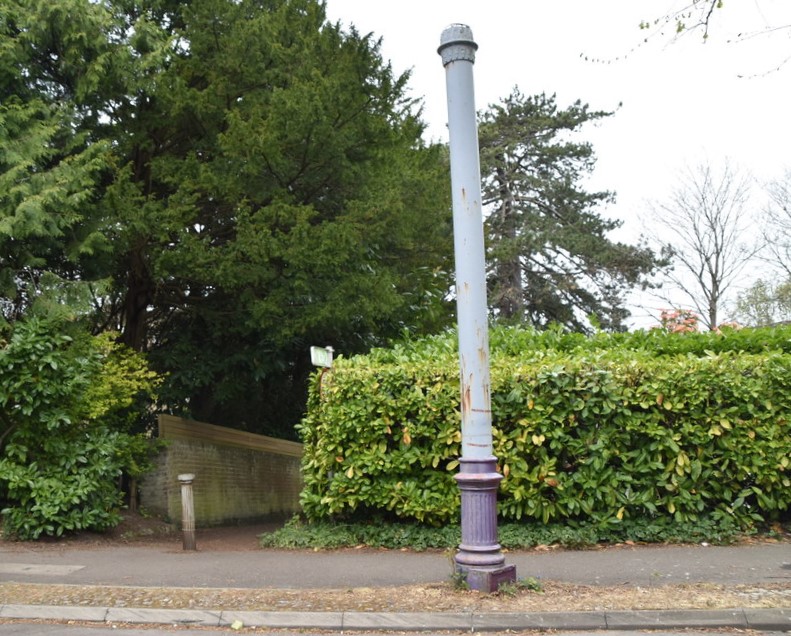Stink pipes

|
| Stink pipes such as this one at Broadwater Down are found above sewers and are there to vent gases from the sewers below. Most stink pipes date from the Victorian period. |
Contents |
[edit] Introduction
Stink pipes (or stench pipes) are Victorian era stack vents placed above drain waste vents (or DWVs). Their purpose is to provide ventilation for pipe networks that handle sewage and greywater.
[edit] History
During the industrial revolution, the River Thames was essentially an open sewer. There were few flush toilets, and waste was simply discharged in cesspits, much of which overflowed into rainwater drains. In addition, there was considerable waste from slaughterhouses and factories.
The summer of 1858 was known as ‘the Great Stink’ in London as there was a strong smell of untreated waste throughout the city, affecting those at work in the House of Commons. Joseph Bazalgette, the chief engineer of London’s Metropolitan Board of Works, proposed channelling waste through street sewers, into main intercepting sewers. These would transport waste towards the tidal part of the Thames so that it would be swept out to the sea.
The network of wide sewer tunnels required venting, which is why stink pipes were incorporated into the system. Based on the concept of a blastpipe - an idea allegedly invented by a Victoria-era surgeon, chemist and engineer named Sir Goldsworthy Gurney - stink pipes were made out of cast iron and placed along main sewer routes.
Some could be more than nine metres tall, which was deemed necessary in order to direct the toxic fumes a suitable distance above street level.
[edit] Iconic structures
Hundreds stink pipes still survive in many of the older towns and cities throughout the UK. Some have been truncated and appear more like bollards than ventilation systems. Others have retained their original stature, including design elements and decorative motifs association with the Victorian period.
Typically green or grey in colour, stink pipes often include plaques that proudly display the names of their manufacturers. People tend walk past them every day and have no idea what they are - nor do they take any notice of them. However, the better preserved pipes are highly regarded by members of the numerous clubs and societies dedicated to the appreciation of this seemingly mundane, but essential part of the urban streetscape.
[edit] Related articles on Designing Buildings
IHBC NewsBlog
Old Sarum fire in listed (& disputed) WW1 Hangar - Wiltshire Council has sought legal advice after fire engulfed a listed First World War hangar that was embroiled in a lengthy planning dispute.
UK Antarctic Heritage Trust launches ‘Virtual Visit’ website area
The Trust calls on people to 'Immerse yourself in our heritage – Making Antarctica Accessible'
Southend Council pledge to force Kursaal owners to maintain building
The Council has pledged to use ‘every tool in the toolbox’ if urgent repairs are not carried out.
HE’s Research Magazine publishes a major study of the heritage of England’s suburbs
The article traces the long evolution of an internal programme to research 200 years of suburban growth
IHBC Context 183 Wellbeing and Heritage published
The issue explores issues at the intersection of heritage and wellbeing.
SAVE celebrates 50 years of campaigning 1975-2025
SAVE Britain’s Heritage has announced events across the country to celebrate bringing new life to remarkable buildings.
IHBC Annual School 2025 - Shrewsbury 12-14 June
Themed Heritage in Context – Value: Plan: Change, join in-person or online.
200th Anniversary Celebration of the Modern Railway Planned
The Stockton & Darlington Railway opened on September 27, 1825.
Competence Framework Launched for Sustainability in the Built Environment
The Construction Industry Council (CIC) and the Edge have jointly published the framework.
Historic England Launches Wellbeing Strategy for Heritage
Whether through visiting, volunteering, learning or creative practice, engaging with heritage can strengthen confidence, resilience, hope and social connections.















Comments
I know them as vent pipes and enjoy spotting them all over the place, often at the head of a sewer. There are many around Weymouth.
So do modern sewers no longer require them ?